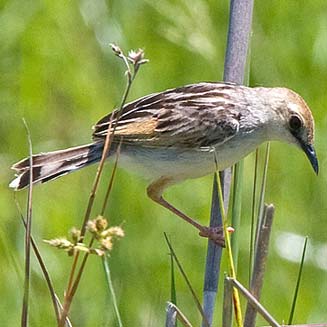|
Cisticola pipiens (Chirping
cisticola)
Piepende tinktinkie [Afrikaans]; Harudeve (generic term
for cisticola or prinia) [Kwangali]; Moerasgraszanger [Dutch]; Cisticole
pépiante [French]; Sumpfzistensänger [German]; Fuinha-chilreadora [Portuguese]
Life
> Eukaryotes >
Opisthokonta
> Metazoa (animals) >
Bilateria >
Deuterostomia > Chordata >
Craniata > Vertebrata (vertebrates) > Gnathostomata (jawed
vertebrates) > Teleostomi (teleost fish) > Osteichthyes (bony fish) > Class:
Sarcopterygii (lobe-finned
fish) > Stegocephalia (terrestrial
vertebrates) > Tetrapoda
(four-legged vertebrates) > Reptiliomorpha > Amniota >
Reptilia (reptiles) >
Romeriida > Diapsida > Archosauromorpha > Archosauria >
Dinosauria
(dinosaurs) > Saurischia > Theropoda (bipedal predatory dinosaurs) >
Coelurosauria > Maniraptora > Aves
(birds) >
Order: Passeriformes > Family: Cisticolidae
> Genus: Cisticola
 |
|
|
Chirping cisticola, Botswana. [photo
Neil Gray
©] |
|
Distribution and habitat
Endemic to south-central Africa, from southern DRC, Angola
and Zambia to southern Africa, specifically northern Namibia and Botswana. Here
it is locally common in waterlogged grassland or reedbeds, often in swamps and
marshes or along rivers.
Food
Little is known about its feeding habits, other than that
it eats insects, especially grasshoppers (Orthoptera).
Breeding
- Both sexes build the nest, which is a ball with a side entrance
constructed out of dry reeds or grass, reinforced and secured with spider
web to the surrounding vegetation. It has a characteristic lip below the
nest entrance, forming a kind of doormat. It is typically placed just above
water or moist soil, in a dense tuft of reeds or grass, which it often
incorporates into the nest.
- Egg-laying season is from about October-April.
- It lays 3-4 eggs, which are incubated by both sexes for approximately 14
days.
- Little is known about the development and care of the young, other than
that they are fed by both parents.
Threats
Not threatened.
References
-
Hockey PAR, Dean WRJ and Ryan PG 2005. Roberts
- Birds of southern Africa, VIIth ed. The Trustees of the John Voelcker
Bird Book Fund, Cape Town.
|
